Itinerary: Tauranga city guide
In this month's Itinerary, supported by Dulux, we visit places of architectural intrigue in this rapidly growing North Island beach town. Works from big-city firms and local talent alike feature on our list of stops.
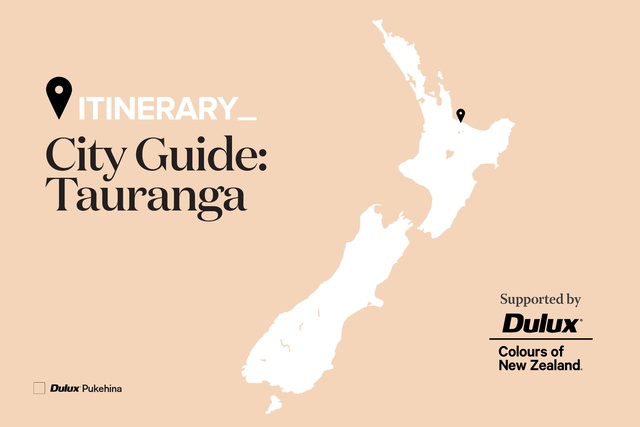
Two ideas about Tauranga ride high in the popular imagination. One is that it’s a city of rapid growth, a place expanding so fast that city authorities can barely keep up. The other is that it’s a party town, host to languid summers on the beach interrupted only by a spike in marginal behaviour on New Year’s Eve. Like most generalisations, these capture something of the story but it is the detail that is fascinating.
While it is true that Tauranga is growing rapidly – in the last 40-odd years, its population has more than tripled and, since 2008, it has raced past both Dunedin and Napier-Hastings to become New Zealand’s fifth-most-populous city – the city has no shortage of history. It was home to intense Māori occupation and became one of our early colonial settlements. A mission station was established in the 1830s: The Elms complex has remained to the present day as the oldest surviving buildings in the Bay of Plenty (and is now open to the public as something of a time capsule of colonial-era life).
After a period of productive exchanges, Tauranga’s early development – as was the case in many other cities – became the cause of bitter conflict. The Waikato Wars eventually reached its gates. The Battle of Gate Pā, an attack on a fortified pā located at what is now the southern end of the central city, inflicted the largest loss of life for the British forces in the wars of the period. There were also less-bloody betrayals. The swathe of land that now comprises the CBD was given to Anglican missionaries by local chiefs to be held in trust for the benefit of tangata whenua. However, the colonial government pressured the missionaries for the land and, under protest, most of it was handed over in 1867, a move for which the Anglican church offered a formal apology to Tauranga Moana iwi in 2018.
Also, as in many provincial centres, big-city architects absorbed many of the key commissions on offer. Tauranga is home to buildings by many of the highest-profile architects of their respective generations – government architects John Campbell and John Mair, Gummer & Ford, Stanley Fearn and, in more recent times, Mitchell & Stout Architects, Jasmax, and Warren and Mahoney. But the region also supported a number of very interesting local practices. Harold West was responsible for significant buildings all around the Bay of Plenty in the early part of last century; he had his own plane and would fly to various towns to carry out work. Edgecumbe & White was based in Hamilton but produced public buildings all around the Waikato and Bay of Plenty through the middle part of the century. Following that practice, local firms, such as Jenkins & Roberts, Acheson & Stewart and Johnston & Denniston, disseminated a gentle brand of modernism. In more recent years, Architecture Page Henderson and Wingate + Farquhar produced notable civic and commercial buildings.
Tauranga is renowned as a recreational hot spot. Since the city’s early days, civic life in the CBD has had to compete with the beaches that stretch away from the city around the harbour and along the coast. The city was also burdened with a train line that still disconnects the CBD from its waterfront. In recent years, though, the city has sought to improve the urban environment, developing the waterfront with parks, playgrounds and a new wharf. It is also boosting cultural facilities with its Art Gallery (2007) and proposed new cultural and community hub. Perhaps more importantly, buildings in the central city have tended to obey one of the cardinal rules of urban design – build to the street line. This means that, despite being of relatively low-density – not much of it more than two storeys high – the city centre feels urbane.
THE ITINERARY
01. 1838–1847 – The Elms Mission Station
15 Mission Street, by George Clark

The Church Missionary Society (CMS) extended its activities into the Bay of Plenty in the mid-1830s and developed the complex of buildings known as The Elms over the next dozen years. The Mission House is the best known of the site’s many buildings and structures. With its symmetry, axiality, hipped roof and tightly cropped eaves, it follows the Georgian language of the CMS’s earlier Northland mission houses – it was likely designed by George Clark, who was also responsible for Te Waimate Mission in Northland. It is still complete with historic fittings, furniture, textiles and books. The house and gardens are open to the public. See theelms.org.nz.
02. 1881 – Brain Watkins House
233 Cameron Road, architect unknown
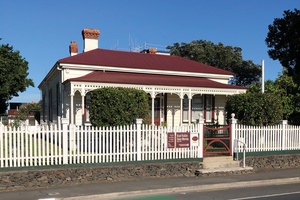
The Brain Watkins House was built by a local boat-builder, Joseph Brain. It demonstrates the late-19th-century residential character of what is now a commercial area. The house was gifted to the Tauranga Historical Society in 1979 by Elva Brain Watkins and is open to the public. It has a square footprint, a central hallway with rooms on either side and a notable collection of historic fittings, furniture, textiles and ephemera associated with the Brain family. Joseph Brain also built the Teasey House at 105 Fourth Avenue.
03. Various – Tauranga Historic Village
159 Seventeenth Avenue, by various architects

The five-hectare Historic Village opened to the public in December 1976 as a ‘living museum’. It comprises a collection of historic and replica buildings and combines retail with venue hire, a bimonthly market, community services, and a park and garden area. The historic buildings include a 19th-century house from the Durham Redoubt, a blacksmith’s shop, a couple of churches and the Foresters Hall (1908). The Tauranga City Council took over the management of the village in 2005. See Historic Places in New Zealand, May 1996, and historicvillage.co.nz.
04. 1905 – Post Office & Govt Building (former)
51 Willow Street, by John Campbell, Goverment Architect

Tauranga’s old government services building burned down in 1902. In its place, the city acquired one of the John Campbell-designed Edwardian Baroque post offices that are easily recognisable in towns and cities throughout the country. It is a two-storeyed building with a rusticated lower level, round arches above some of the openings, broken pediments and a domed corner clock tower. The southern end is an addition. The building survived a threat of demolition in the 1990s and today functions as a bar, restaurant and boutique hotel. See clarencetauranga.co.nz.
05. 1935 – Hardley’s Building
31 Devonport Road, by Harold L. D. West

Devonport Road is home to a cluster of commercial buildings built in the 1930s when Tauranga’s CBD was consolidated and expanded. The Hardley’s Building is considered to be a representative example of this commercial development. It retained the symmetry of classicism but exterior ornamentation was being reduced in this period and the size of the windows was increasing. It housed retail downstairs and residential upstairs. Harold West designed a similar building at 45 The Strand (1936). He became Tauranga’s Borough Architect.
06. 1938, 1942 – Post Office (former)
1 Grey Street, by John Mair, Government Architect
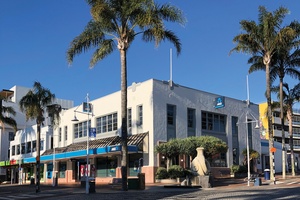
This Art Deco gem took over postal duties from John Campbell’s 1905 building. It was designed by Hamilton-based practice Edgecumbe & White under the direction of Government Architect John Mair. Producing public buildings all around the Waikato and Bay of Plenty, Edgecumbe & White is best known for Hamilton’s old Post Office, now home to SkyCity. Originating in the 1910s in the firm of Warren & Blechynden, Edgecumbe & White had the distinction of being the only Hamilton architectural practice to survive the depression, evolving into Leigh, de Lisle & Fraser in the postwar period and the contemporary firm of Smith Pickering.
07. 1955, 2000 – Public Trust Building (former)
29 Grey Street, by Stanley Fearn and Matrixx
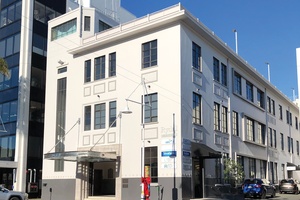
Public Trust offices of the early and mid-20th century were important buildings in many New Zealand cities, and Wellington architect Stanley Fearn designed a number of them, including this one. At the time of completion, this three-storeyed building, known today as Rydal House, was one of the city centre’s landmark buildings. This one gives a nod to the modern, with an asymmetrical vertical circulation tower, but it retained tripartition, an axial main entrance, more conservative fenestration than many mid-1950s’ office buildings, and a heavy cornice.
It was renovated by Matrixx in 2000.
08. 1956, 1991 – St Mary Immaculate Church
114 Elizabeth Street, by Pipe & Sargent and David Gatley

St Mary’s is the oldest Catholic parish in New Zealand, established by Bishop Pompallier in 1840. It has occupied a sequence of interesting buildings, including a timber church by Auckland architects Edward Mahoney & Son, built in 1888, and a modernist chapel by locals Pipe & Sargent. The 1950s’ building was absorbed into a renovation and extension project in the 1990s. Designed by Tauranga architect and parishioner David Gatley, the semi-circular worship space could seat 550 people, making it the largest church in the Bay of Plenty at the time.
09. 1957 – Tauranga Fire Station
189 Cameron Road, by Norman Jenkins
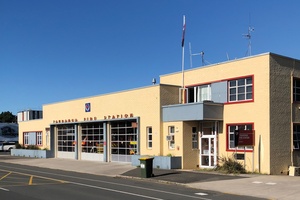
A representative example of the work of Norman Jenkins, and his firm Jenkins & Roberts, this project is typical of the low-key modernism that underpinned the rapid development of our towns and cities in the postwar period. The building is still in near-original condition but, at 60 years old, it is part of a generation of structures that are being demolished or renovated into oblivion. Other interesting Jenkins & Roberts projects that still survive include Te Matahauraki (1967, 1991) at 7 The Strand and Pyes Pa Crematorium (1967) at 403 Pyes Pa Road.
10. 1983 – Baycourt Community and Arts Centre
38 Durham Street, by Warren and Mahoney

Completed in the same year as was the Michael Fowler Centre in Wellington, this project is one of Warren and Mahoney’s ‘constructivist’ buildings. These projects – characterised by heavy pitched roofs and expressed structures in various combinations – form an interesting bridge between the brutalism of the 1960s and 1970s, and the pastel PoMo of the late-1980s. It was opened by Charles and Diana during their famous national tour. Interestingly, this building isn’t included in the chronology of Warren and Mahoney’s major retrospective New Territory monograph, despite its winning an NZIA Regional Award in 1984.
11. 2003 – Holy Trinity Anglican Church
215 Devonport Road, by Architecture Page Henderson
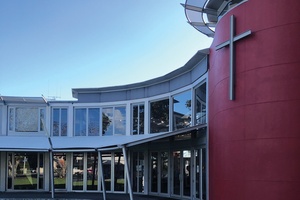
There has been a congregation at Holy Trinity for 145 years, always active in the life of the city – the church’s first vicar was also mayor of Tauranga. This project replaced the original building on the site, which was built in 1875 but destroyed by fire in 2000. The design sought to reconsider the ways in which church buildings might provide for the various activities taking place within, and careful planning of the intersecting circular volumes creates dynamic relationships between the various spaces and connections out to the street. The building won an NZIA Local Award in 2003. See Architecture NZ Nov/Dec 2002.
12. 2007 – Tauranga Art Gallery
108 Willow Street, by Mitchell and Stout Architects

Bestowing an NZIA National Award in 2009, the jury wrote: “With consummate skill, a former bank has been stripped back and reinvented as an art gallery on a significant corner in Tauranga’s CBD. Innovative use of overlapping cool-store panels as cladding and a lively colour scheme mark this as a place for art while generous street-level glazing encourages entry… Simple lighting, subtle finishes, discreet services installation and sophisticated but plain detailing ensure the exhibits claim the foreground. Clever, approachable and fun, this gallery celebrates the place of art in the community.” See Architecture NZ Jan/Feb 2008.
13. 2012 – ANZ Business Centre
247 Cameron Road, by Wingate + Farquhar

Composed as two linked blocks – one slick and glassy, the other slipped behind an egg-crate of sunshades – this crisp, modernist composition contributes to the cityscape. Sitting on a key street corner, the building helps define the otherwise-rather-ragged edge of the CBD. The building is home to several Wingate + Farquhar interiors – the Elizabeth Cafe and Larder (also 2013) is a good spot for a rest – and won several NZIA Local Awards in 2013. Wingate fans might pop down to 145 Seventeenth Avenue to visit The Kollective, New Zealand’s largest co-working office, completed in 2018.
14. 2016 – Trustpower HQ
108 Durham Street, by Wingate Architects

Headquarters for a locally based corporate, this building is restrained but urbane – the block is low-rise but presses up against all the site boundaries, strengthening the space of the street. The crisp and cool building shell is by Wingate, with the warm and woody interior fit-out by Warren and Mahoney. Internally, the open-plan office spaces are wrapped around a dramatic top-lit atrium. The building fully embraces modern corporate culture so there are no enclosed offices – not even for the boss. It was the winner of an NZIA Local Award in 2016.
15. 2019 – University of Waikato Tauranga CBD Campus
101–121 Durham St, by Jasmax

Another large building filling in a section of the central city, this project was the recent recipient of an NZIA National Award. The project consolidated previously scattered faculties and is characterised by integration: of partnership with mana whenua, of work by artist Whare Thompson and of Tauranga streetscapes. The complex’s strong textures and forms are arranged around a sequence of dramatic interior and exterior spaces and, like many other new buildings in the CBD, it makes the key move of building to the lot lines, strengthening the urban structure. See Architecture NZ Nov/Dec 2020.
Other addresses
War Memorial Gates (1921, 2014) – Tauranga Domain, 45 Cameron Road, by Gerard Ward & Salmond Reed Architects.
New Zealand Insurance Building (former) (1958) – 57 Spring Street, by Gummer, Ford & Partners.
AMP Regional Offices (1980) – 181 Devonport Road, by Denniston Hodgson Architects.
Salvation Army Centre (1981) – 51 Fifth Avenue, by Acheson & Stewart.
Kathleen Kilgour Centre (2014) – 18 Twentieth Avenue, by Wingate + Farquhar.
Tauranga Waterfront (2017) – Wharf Street, by LandLAB.
The itinerary series is supported by Dulux Colours of New Zealand. Dulux Colour Specialist Davina Harper has selected a Colours of New Zealand palette based on this itinerary. See the full range and order colour samples here.

Sources
With the exception of The Elms, there is not much in Tauranga that features in our architectural history books. Alan Bellamy’s general, if a little old, history of Tauranga incidentally tells the story of many of the city’s key buildings – Tauranga 1882–1982 (Tauranga: Tauranga City Council, 1982). A couple of times in the 1960s and 1970s, Home & Building magazine filled a whole issue with new Waikato and Bay of Plenty buildings – track down the April 1969 and February 1973 issues. The Elms has its own website. For detail on other buildings, visit Google to locate the Tauranga CBD Heritage Study Draft Record Forms, and the Central Tauranga Heritage Study, prepared in 2008 for the Tauranga City Council by Matthews and Matthews Architects in association with Jinty Rorke, Jennie Gainsford, Lisa Truttman and R. A. Skidmore & Associates.









